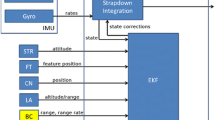Abstract
In the present work, an existing approach to the deployment of navigation system for use in lunar missions is further developed. The operation of radio navigation systems based on the mean wavelength and the query model of data transmission is discussed. The navigation stations are assumed to be deployed in the vicinity of potential landing points and the site of the lunar base. The beacon distribution is selected so as to ensure maximum coverage and expansion of the navigation zone, taking account of the actual relief of the lunar surface in the specified sectors.


Similar content being viewed by others
REFERENCES
Akimov, E.V., Kozorez, D.A., and Kruzhkov, D.M., Navigation solution concept and its practical approach development for Lunar missions, Russ. Eng. Res., 2020, vol. 40, no. 7, pp. 605–607.
Voiskovskii, A.P., Kuznetsov, K.V., and Yakimenko, V.A., Adaptive algorithms in a universal integrated navigation system based on low-cost instruments, Russ. Eng. Res., 2021, vol. 41, no. 1, pp. 68–71.
Artemis lunar exploration program. https://www.nasa.gov/what-is-artemis. Accessed September 1, 2020.
Mission Artemis 3. http://www.fue.es/moonchallengebyfue/PDFS/MISION-ARTEMIS-3.pdf. Accessed September 1, 2020.
Xu, L., Zou, Y., and Jia, Y., China’s planning for deep space exploration and lunar exploration before 2030, Chin. J. Space Sci., 2018, vol. 38, no. 5, pp. 591–592. https://epizodsspace.airbase.ru/bibl/inostr-yazyki/Chinese_Journal_of_Space_Science/2018/5/Xu_et_al_China's_Planning_—_before_2030_Chin_J_Space_Sci_ 38_(2018).pdf. Accessed September 1, 2020.
Zou, Y., Xu, L., and Jia, Y., A tentative plan of China to establish a Lunar Research Station in the next ten years, Proc. 42nd Scientific Assembly of the Committee on Space Research, Pasadena, CA, Paris: Com. Space Res., 2018. https://ui.adsabs.harvard.edu/abs/2018cosp…42E3886Z/ abstract. Accessed September 1, 2020.
Future Chinese Lunar missions. https://nssdc.gsfc.nasa.gov/planetary/lunar/cnsa_moon_future.html. Accessed September 1, 2020.
Mitrofanov, I.G., Landing areas of the Luna-25 spacecraft, 2018. http://sovet.cosmos.ru/sessions/2018-01-23. Accessed September 1, 2020.
Moon LRO LOLA color shaded relief 388 m v. 4. https://astrogeology.usgs.gov/search/map/Moon/LMMP/ LOLA-derived/Lunar_LRO_LOLA_ClrShade_Global_ 128ppd_v04. Accessed September 1, 2020.
Golubev, S.I., Malyshev, V.V., Piyavskii, S.A., and Sypalo, K.I., Decision making in multicriteria problems at the image design stage of aviation rocket technique, J. Comput. Syst. Sci. Int., 2020, vol. 59, no. 2, pp. 223–231.
Author information
Authors and Affiliations
Corresponding author
Additional information
Translated by B. Gilbert
About this article
Cite this article
Kozorez, D.A., Kruzhkov, D.M. Selecting the Beacon Locations in a Radio Navigation System for Lunar Missions. Russ. Engin. Res. 41, 756–758 (2021). https://doi.org/10.3103/S1068798X21080189
Received:
Revised:
Accepted:
Published:
Issue Date:
DOI: https://doi.org/10.3103/S1068798X21080189




